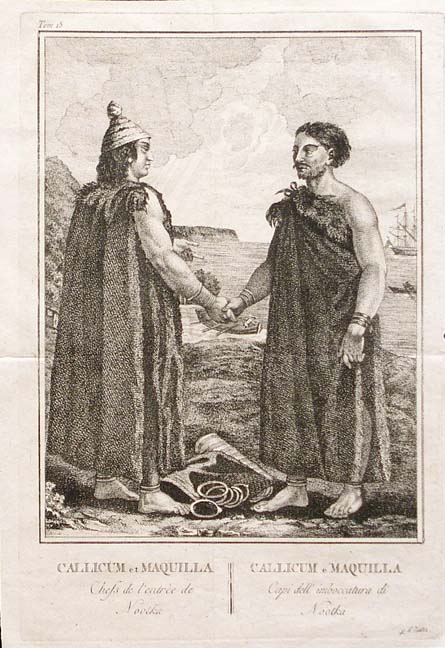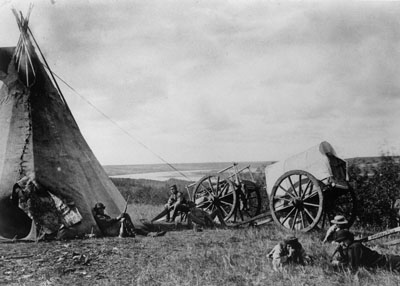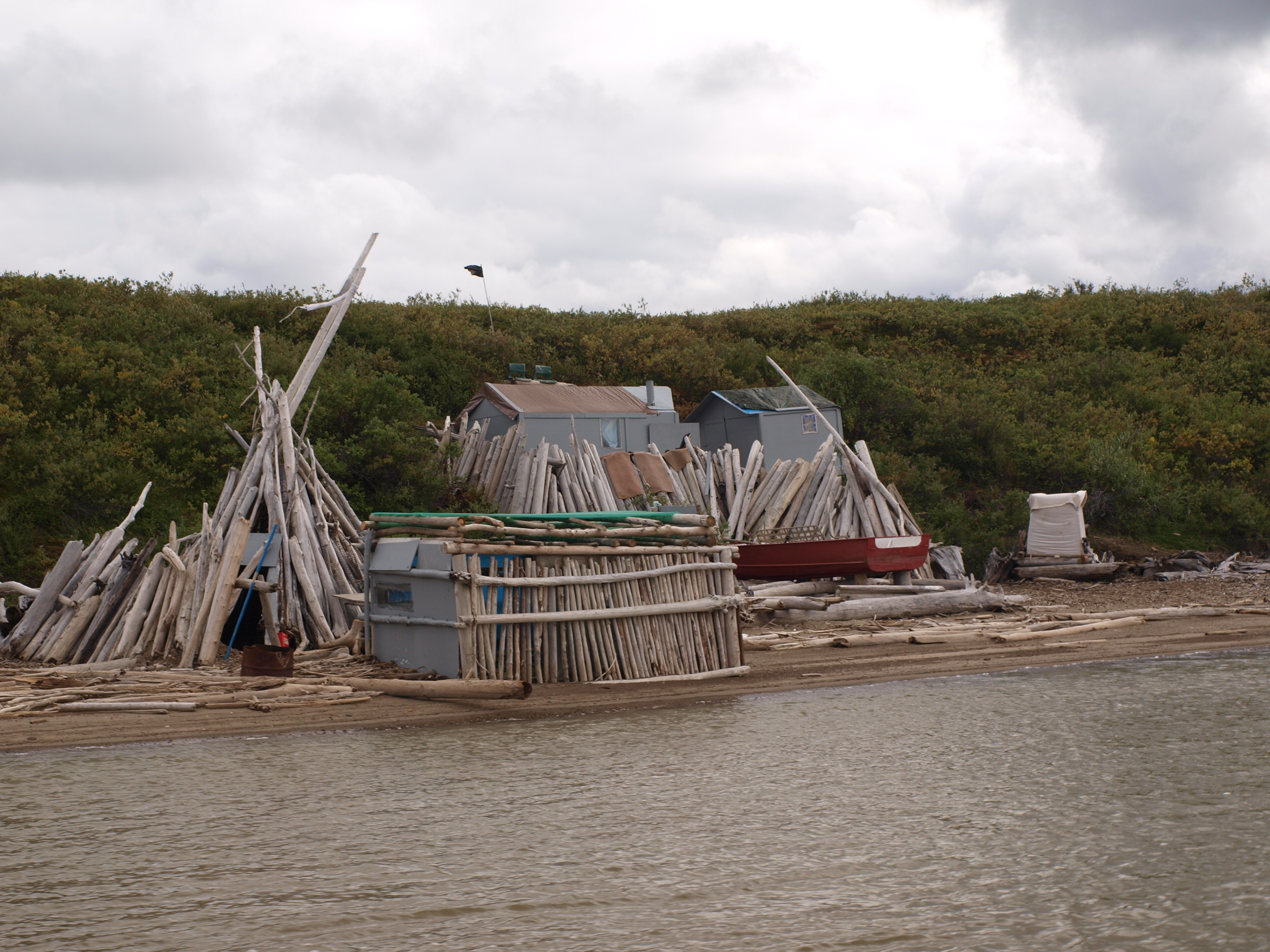Browse "Indigenous Peoples"
-
Article
Louis Levi Oakes
Louis Levi Oakes (also known as Tahagietagwa), Mohawk soldier, war hero, steelworker, public works supervisor (born 23 January 1925 in St. Regis, QC; died 28 May 2019 in Snye, QC). During the Second World War, Oakes was a code talker for the United States Army. Code talkers used their Indigenous languages to encode radio messages to prevent the enemy from understanding them. When he passed away at age 94, Oakes was the last Mohawk code talker. (See also Cree Code Talkers and Indigenous Peoples and the World Wars.)
"https://d2ttikhf7xbzbs.cloudfront.net/louislevioakes1.jpg" // resources/views/front/categories/view.blade.php
https://d2ttikhf7xbzbs.cloudfront.net/louislevioakes1.jpg
-
Article
Inuvialuit
Inuvialuit originally occupied the western Canadian arctic coast from Barter Island in the west to Cape Bathurst in the east, as well as the northern portion of the Mackenzie River Delta. Numbering about 2000 during the 19th century, they formed the densest Inuit population in arctic Canada.
"https://d2ttikhf7xbzbs.cloudfront.net/media/media/ccebcf67-46af-4adf-9573-a62d629020eb.JPG" // resources/views/front/categories/view.blade.php
https://d2ttikhf7xbzbs.cloudfront.net/media/media/ccebcf67-46af-4adf-9573-a62d629020eb.JPG -
Article
Malcolm Frederick Norris
Malcolm Frederick Norris, Métis leader (born 25 May 1900 in St. Albert, North-West Territories [now Alberta]; died 5 December 1967 in Calgary, Alberta). A tireless and militant activist, Norris advocated on behalf of Indigenous peoples on a variety of platforms, from discussions with the federal government about Indigenous issues to concerns that primarily affected Métis communities in Canada. Remembered as a brilliant orator in English and Cree, Norris was a key figure in the Association des Métis d’Alberta et des Territoires du Nord Ouest, the Indian Association of Alberta and the Métis Association of Saskatchewan. He is also widely recognized as one of the 20th century’s most important and charismatic Métis leaders.
"https://d2ttikhf7xbzbs.cloudfront.net/media/media/4de10db1-6b8b-45ef-a60a-55998c7afca0.jpg" // resources/views/front/categories/view.blade.php
https://d2ttikhf7xbzbs.cloudfront.net/media/media/4de10db1-6b8b-45ef-a60a-55998c7afca0.jpg
-
Article
Wolastoqiyik (Maliseet)
Wolastoqiyik (also Welastekwewiyik or Welustuk; pronounced wool-las-two-wi-ig), meaning “people of the beautiful river” in their language, have long resided along the Saint John River in New Brunswick and Maine, and the St. Lawrence River in Quebec. Historically, the Europeans referred to the Wolastoqiyik by a Mi’kmaq word, Maliseet (or Malecite), roughly translating to English as “broken talkers.” The name indicates that, according to the Mi’kmaq, the Wolastoqiyik language is a “broken” version of their own. Today, there are Wolastoqiyik communities in Quebec and the Maritimes as well as in Maine. In the 2016 census, 7,635 people identified as having Wolastoqiyik ancestry.
"https://d2ttikhf7xbzbs.cloudfront.net/media/media/e1ee186b-01fe-471d-9adc-32223da5830f.jpg" // resources/views/front/categories/view.blade.php
https://d2ttikhf7xbzbs.cloudfront.net/media/media/e1ee186b-01fe-471d-9adc-32223da5830f.jpg
-
Article
Maquinna
Maquinna, or Mukwina, meaning "possessor of pebbles", was a Nuu-chah-nulth (Nootka) chief (fl. 1778-95). Maquinna was the ranking leader of the Moachat group of Nootka Sound Indigenous peoples on the west coast of Vancouver Island during the early years of European contact.
"https://d2ttikhf7xbzbs.cloudfront.net/media/media/0e25e8d6-1ac5-4a3e-a0a1-2b008d46ae99.jpg" // resources/views/front/categories/view.blade.php
https://d2ttikhf7xbzbs.cloudfront.net/media/media/0e25e8d6-1ac5-4a3e-a0a1-2b008d46ae99.jpg
-
Article
Margaret Pictou LaBillois
Margaret Pictou LaBillois, CM, ONB, air force photographer, businesswoman, Mi’kmaw Chief, Elder, language and culture advocate (born 10 July 1923 in Eel River Bar First Nation [now Ugpi’Ganjig] NB; died 19 April 2013 in Dalhousie, NB). Elder Margaret LaBillois was the first elected female Chief in New Brunswick. After wartime service, LaBillois returned to her First Nation, where she was instrumental in reviving an interest in the Mi’kmaw language and traditional crafts, as well as starting a family co-operative business.
"https://d2ttikhf7xbzbs.cloudfront.net/MargaretPictouLaBillois/New_Brunswick_Micmac_Chief_45_Years_Ago_3024835508_resized.jpg" // resources/views/front/categories/view.blade.php
https://d2ttikhf7xbzbs.cloudfront.net/MargaretPictouLaBillois/New_Brunswick_Micmac_Chief_45_Years_Ago_3024835508_resized.jpg
-
Article
Maria Campbell
Maria Campbell, O.C., Cree-Métis writer, playwright, filmmaker, scholar, teacher and elder (born 26 April 1940 in Park Valley, SK). Campbell’s memoir Halfbreed (1973) is regarded as a foundational piece of Indigenous literature in Canada for its attention to the discrimination, oppression and poverty that some Métis women (and Indigenous people, in general) experience in Canada. Campbell has authored several other books and plays, and has directed and written scripts for a number of films. As an artist, Campbell has worked with Indigenous youth in community theatre and advocated for the hiring and recognition of Indigenous people in the arts. She has mentored many Indigenous artists during her career.
"https://d2ttikhf7xbzbs.cloudfront.net/media/media/f6caf3ae-64fb-495c-b470-7076e84db436.jpg" // resources/views/front/categories/view.blade.php
https://d2ttikhf7xbzbs.cloudfront.net/media/media/f6caf3ae-64fb-495c-b470-7076e84db436.jpg
-
Article
Marie-Anne Day Walker-Pelletier
Marie-Anne Day Walker-Pelletier, CM, chief (born 15 April 1954 in Regina, SK). Day Walker-Pelletier is the longest-serving elected chief in Canadian history. She was chief of Okanese First Nation, located near Fort Qu’Appelle, Saskatchewan, from 1981 to 2020. During her long career, Day Walker-Pelletier accomplished many goals, including establishing the structure, instruments and policies of governance for Okanese First Nation. She also took part in numerous projects related to wellness, social reform and education, focusing primarily on providing support to vulnerable women and children. Day Walker-Pelletier has been a strong advocate for preserving the language, traditions, and treaty rights of Okanese First Nation.
"https://d2ttikhf7xbzbs.cloudfront.net/MarieAnneDayWalkerPelletier/CanadaPostDayWalkerPelletier.png" // resources/views/front/categories/view.blade.php
https://d2ttikhf7xbzbs.cloudfront.net/MarieAnneDayWalkerPelletier/CanadaPostDayWalkerPelletier.png
-
Article
Marie-Anne Lagimodière
Marie-Anne Lagimodière (née Gaboury), settler (born 2 August 1780 in Maskinongé, QC; died 14 December 1875 in St. Boniface, MB). Marie-Anne Lagimodière accompanied her fur-trader husband, Jean-Baptiste Lagimodière, to what is now Western Canada. She was one of the first women of European descent in the area and they became some of the first settlers in Red River. Marie-Anne Lagimodière was grandmother of Louis Riel, the Métis leader of the Red River Resistance.
"https://d2ttikhf7xbzbs.cloudfront.net/Lagimodieres.jpg" // resources/views/front/categories/view.blade.php
https://d2ttikhf7xbzbs.cloudfront.net/Lagimodieres.jpg
-
Article
Markoosie Patsauq
Markoosie Patsauq, Inuk writer, pilot, community leader (born 24 May 1941 near Inukjuak [then Port Harrison], QC; died 8 March 2020 in Inukjuak, QC). The life of Markoosie Patsauq intersected dramatically with many of the most significant events affecting Inuit in 20th century Canada. He survived upheaval and trauma, both collective and individual, and went on to be the first Inuk and the first Indigenous person in Canada to publish a novel. Uumajursiutik unaatuinnamut, or Hunter with Harpoon, appeared serially in 1969–70 in Inuktitut and then as an English adaptation in late 1970. Patsauq’s writing career spanned many decades and included fiction as well as essays on topics ranging from his flying career to his experiences of colonization and injustice. (See also Influential Indigenous Authors in Canada.)
"https://d2ttikhf7xbzbs.cloudfront.net/MarkoosiePatsauq/MarkoosiePatsauq.JPG" // resources/views/front/categories/view.blade.php
https://d2ttikhf7xbzbs.cloudfront.net/MarkoosiePatsauq/MarkoosiePatsauq.JPG -
Article
Marshall Case
The Marshall case is a landmark ruling in Indigenous treaty rights in Canada. The case centres on Donald Marshall Jr., a Mi’kmaq man from Membertou, Nova Scotia. In August 1993, Marshall caught and sold 210 kg of eel with an illegal net and without a licence during closed-season times. He was arrested after being charged under the federal Fisheries Act and the Maritime Provinces Fishery Regulations. In Marshall’s court case, R. v. Marshall, he was found guilty on all three charges in provincial court (1996) and appeals court (1997). The Supreme Court of Canada reversed Marshall’s convictions in September 1999. The Supreme Court recognized the hunting and fishing rights promised in the Peace and Friendship Treaties. These treaties were signed between the British and the Mi’kmaq, Wolastoqiyik and Peskotomuhkati in 1760–61.
"https://d2ttikhf7xbzbs.cloudfront.net/media/media/0696b0d3-e259-4e89-8895-f6296d7ab589.JPG" // resources/views/front/categories/view.blade.php
https://d2ttikhf7xbzbs.cloudfront.net/media/media/0696b0d3-e259-4e89-8895-f6296d7ab589.JPG -
Article
Mary Two-Axe Earley
Mary Two-Axe Earley, Kanien’kehá:ka (Mohawk) elder, advocate for women and children, human rights activist (born 4 October 1911 on the Kahnawà:ke reserve, QC; died 21 August 1996 in the same place). Mary Two-Axe Earley was a pioneer and architect of the Canadian women’s movement. Her political activism helped to forge a coalition of allies to challenge Canadian laws that discriminated against Indigenous women. The great bulk of her political advocacy spanned the last three decades of her life, and she was particularly active in the 1960s, 1970s and 1980s.
"https://d2ttikhf7xbzbs.cloudfront.net/media/Twitter_Cards/Mary two-axe 1.png" // resources/views/front/categories/view.blade.php
https://d2ttikhf7xbzbs.cloudfront.net/media/Twitter_Cards/Mary two-axe 1.png
-
Article
McIvor Case
The McIvor v. Canada case was about gender discrimination in section 6 of the 1985 Indian Act, which deals with Indian status. Sharon McIvor — a woman who regained status rights after the passing of Bill C-31 in 1985 — was not able to pass on those rights to her descendants in the same way that a man with status could. In her case against the federal government, the British Columbia Supreme Court ruled in 2007 that section 6 did, in fact, deny McIvor’s equality rights under the Canadian Charter of Rights and Freedoms. In response to this case, the federal government introduced new legislation (Bill C-3) in 2011 to counter gender discrimination in the Indian Act.
"https://d2ttikhf7xbzbs.cloudfront.net/McIvorCase/McIvor.jpg" // resources/views/front/categories/view.blade.php
https://d2ttikhf7xbzbs.cloudfront.net/McIvorCase/McIvor.jpg
-
Article
Métis
Métis are people of mixed European and Indigenous ancestry, and one of the three recognized Aboriginal peoples in Canada. The use of the term Métis is complex and contentious, and has different historical and contemporary meanings. The term is used to describe communities of mixed European and Indigenous descent across Canada, and a specific community of people — defined as the Métis Nation — which originated largely in Western Canada and emerged as a political force in the 19th century, radiating outwards from the Red River Settlement (see Métis Are a People, Not a Historical Process and The “Other” Métis). While the Canadian government politically marginalized the Métis after 1885, they have since been recognized as an Aboriginal people with rights enshrined in the Constitution of Canada and more clearly defined in a series of Supreme Court of Canada decisions.
"https://d2ttikhf7xbzbs.cloudfront.net/media/media/254ae37e-4c7d-44d9-8b00-073d5d80a1b2.jpg" // resources/views/front/categories/view.blade.php
https://d2ttikhf7xbzbs.cloudfront.net/media/media/254ae37e-4c7d-44d9-8b00-073d5d80a1b2.jpg
-
Collection
Métis
This collection features content related to Métis communities in Canada.Through the use of videos, articles and more, it explores issues concerning Métis history, identity and culture.
"https://d2ttikhf7xbzbs.cloudfront.net/media/media/8422126e-7f18-4afa-bcb5-87c5f1e6825a.jpg" // resources/views/front/categories/view.blade.php
https://d2ttikhf7xbzbs.cloudfront.net/media/media/8422126e-7f18-4afa-bcb5-87c5f1e6825a.jpg



